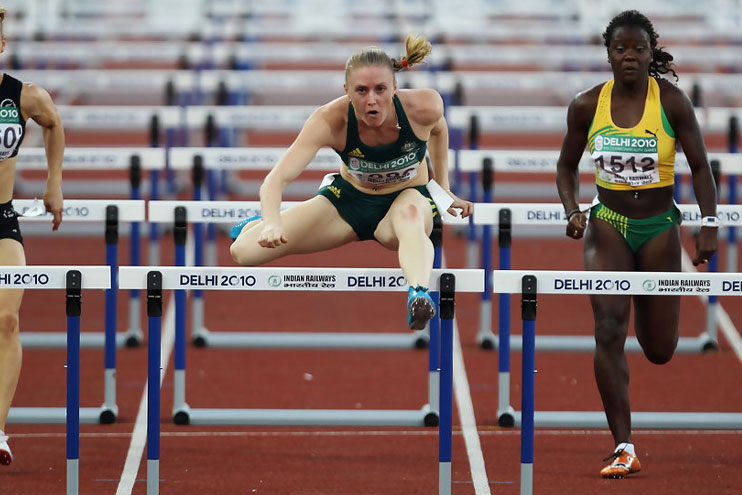
On the 10-year anniversary of the Delhi 2010 Commonwealth Games, Ian Hanson spoke up with athletics champion Sally Pearson about how the Games in India proved to be a significant moment in her golden career.
Sally Pearson knows all about hurdles, she has spent a lifetime clearing them, she could leap those 10 hurdles in her sleep, all the way to an Olympic gold.
The determined Queenslander would follow our nation’s track and field golden girls – Shirley Strickland, Marjorie Jackson, Betty Cuthbert, Maureen Caird, Glynis Nunn, Debbie Flintoff-King and Cathy Freeman, becoming only the eighth woman in Australian athletics history to stand on top of the Olympic podium by herself.
But before she won the Olympic gold at the London 2012 Games, the year of 2010 was a year of more than just those 10 hurdles on the track, a year Pearson never ever forget and in many respects a year that defined the woman who would become one of Australia’s athletic greats.
On the 10th anniversary of the Delhi Commonwealth Games, new mum Sally, takes time out to reflect on a year that had just about everything, from a slow start to the year after managing her painful on-going back injury, to her Gold Coast marriage to fiancé Keiran Pearson, through to the dramatic disqualification in the 100m final in Delhi, three days before winning her first-ever international gold in the 100m hurdles.
Delhi proved to provide the hurdles champion with the highest of highs, but also one of the lowest points of her illustrious career, with a memorable and painful international debut in the 4x400m relay which left her physically ill and hallucinating post-race, a sensation she never wants to experience again.
“2010 was almost a comeback year for me… in 2009, the year after I won silver in Beijing in 2008 I thought I was invincible and could do anything,” Pearson recalled.
“I’d kept racing and racing and training and enjoying the moment as you should do as well but then not listening to my body.
“I suffered a horrendous back injury which lasted years and years, and I was constantly trying to manage throughout the peak of my career unfortunately.
“So 2010 was a slower start for me, I wasn’t doing as much racing and Keiran and I had also got married that year as well but it was a year that really set me up for 2011 and 2012.
“The Delhi Games were super important to me because it was my first international gold medal in an individual event as well, and then to go into 2011 and 2012 with the most confidence you could have.”
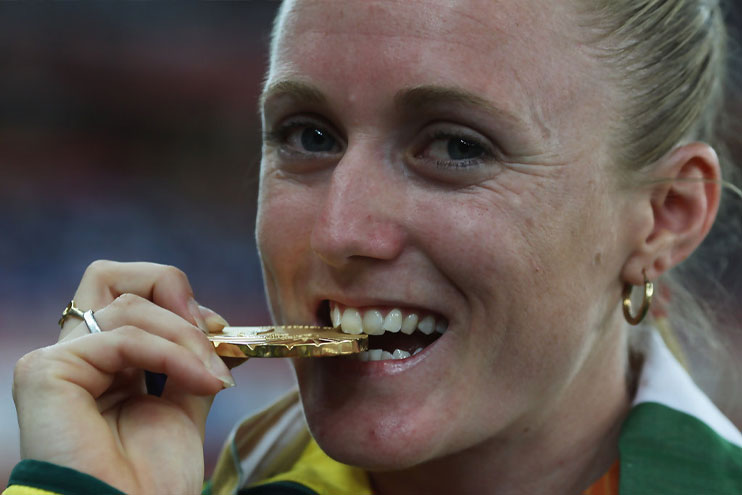
Sally Pearson wins her first major individual gold medal at the Delhi 2010 Games. (CGA Archive)
“If you are going to face that pressure and that expectation from others you have to be fully physically fit and confident in your body and as strong as steel in your mind to be able to handle whatever is thrown at you over the years that come after that.”

Sally Pearson wins her first major individual gold medal at the Delhi 2010 Games. (CGA Archive)
However it had already been a long road to this moment for the now Commonwealth champion, Sally had started her international career as a 19-year-old at the Commonwealth Games in Melbourne in 2006 winning a bronze medal in the 4x100m relay.
The bronze medal, came days after the then teenager had made her first major final, the women’s 100m hurdles, but tragedy struck when then Sally McLellan tripped on a hurdle and fell whilst in a position to challenge for the medals.

Then Sally McLellan falls during the hurdles final at the Melbourne 2006 Games. (CGA Archive)
Knowing how important it was to have the Commonwealth Games experience behind her, albeit a difficult result, it was beneficial as Sally were preparing for her first Olympics in Beijing in 2008 where she went on to win the silver medal, so being able to break through and learn how to win at Delhi 2010, bode well for her confidence in the lead up to London
“For late teenagers and early 20-year-olds when you are coming through the ranks and you really want to make it and to be seen on the international stage and seen as a fierce competitor, there is no doubt I think the Commonwealth Games can really do that for the younger athletes,” Pearson said.
“The young athletes can see what it is like to compete internationally, to understand the pressures and expectations involved with it and to be able to step it up.
“Its a huge step from the junior ranks, competing in World Juniors to being in the senior ranks and competing internationally.
“For me, it was a huge learning curve on how to focus on myself and on my event and what I wanted to achieve in my events as well and I certainly didn’t think that in 2006 I would be going into 2008 and getting a medal in London two years later.”
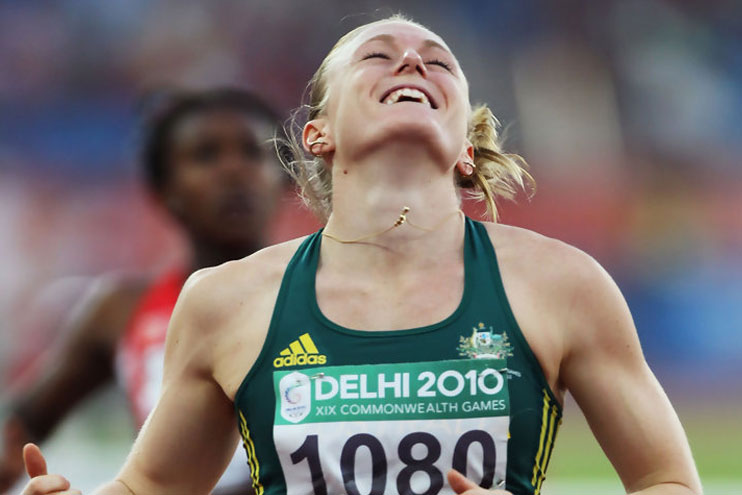
The sweet relief of victory for Pearson at Delhi 2010. (CGA Archive)
The experiences from Melbourne 2006 helped Sally cope with experiences in Beijing, experiences a younger athlete could be overwhelmed by.
“That was something that was incredible really – and it took a whole different mindset going in there and having the confidence I think and those younger years at the Commonwealth Games really helped me to be able to handle myself.
“Especially (looking back) at Melbourne where there was 90,000 people in the stadium and then going into an Olympic Games with the same amount of people in the stadium watching.
“I kind of got used to it and enjoyed it and I realised I did enjoy running in front of a huge crowd like that, I thrived on it and I didn’t have to really worry about focusing on that and how I’m going to handle myself.
“It’s definitely a big learning curve coming into a Commonwealth Games and then to springboard into an Olympics.
But then came a hurdle she’s didn’t expect, the challenges she would face at the Delhi 2010 Commonwealth Games.
For Pearson, Delhi was certainly “a rollercoaster” with the decision to run the 100m flat as well as the hurdles, her pet event.
The decision to run in the 100m became an experience unlike in other in the athlete’s career.

Sally Pearson winning the 100m final before being disqualified. (CGA Archive)
It proved to be a drama-charged 100m final in Delhi when the race was met with a raucous crowd. After many athletes commented crowds had been reserved in creating atmosphere earlier in the Games, on this night they were full-throated, to a point where the resounding noise caused a heightened sense of tension across the field, a tension which proved too much for England’s Laura Turner who broke from the blocks with Pearson joining her in faulting to the naked eye.
Technology trackside recorded Turner had broken 0.001 seconds before Pearson, therefore Turner was disqualified by the officials.
However, the Englishwoman disputed the ruling, and remained in the field but ran the final under protest.
The now nervous competitors lined up on the blocks a second time, before the starter’s gun went, and Pearson went on to win what she thought was her first major individual gold medal.
A jubilant Pearson, celebrated upon crossing the line first and went about completing a lap of honour, only to be told later as she waited for the medal presentation there was a further protest from the English team.
Not knowing what was going on in the corridors of power that England had fired in another protest against Pearson’s break from the blocks, which was sensationally upheld and the Australian was now also disqualified.
A decision coming some four hours later from the running of the final, leaving Pearson distraught with the result.
Looking back on those dramatic scenes that unfolded in Deli surrounding the 100m Pearson admitted the whole saga was certainly disappointing.
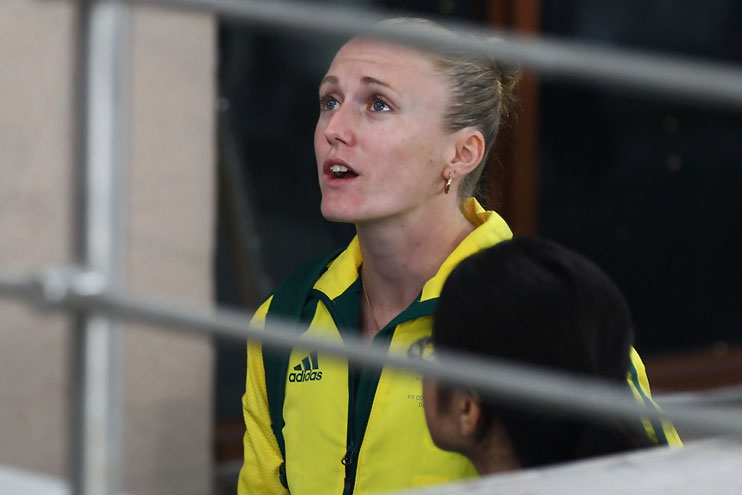
Sally Pearson after being disqualified from her victory in the 100m final. (CGA Archive)
“I obviously thought that I had false started as well but didn’t realise that the English girl had also jumped,” Pearson said.
“It was a bit disappointing to see the way they did it.
“I did see the interview afterwards of the English who protested against me and it did look a little bit disrespectful and I could see a little bit of ‘stuff you…I’m going to do this and make it hurt for you.’
“And it did hurt.
“It was devastating and obviously the rules are the rules but the officials didn’t pick it up straight away, which would have been nice to hang on to that medal but these things happen and you earn from them.
“I think I grew as a person that day and as an athlete, to be able to pick myself up and get ready for the hurdles.
“I don’t think it physically affected my performance in the hurdles and I don’t think I would have run any faster or done anything differently in the hurdles… so I guess it is just one of those things… another tale to put into the story.
“I had to get over the 100 quickly, yes you are disappointed and you can’t dwell on things… in sport it just moves without you.
“If you are not ready for it, it’s just going to keep going and keep going, whether you like it or not.”
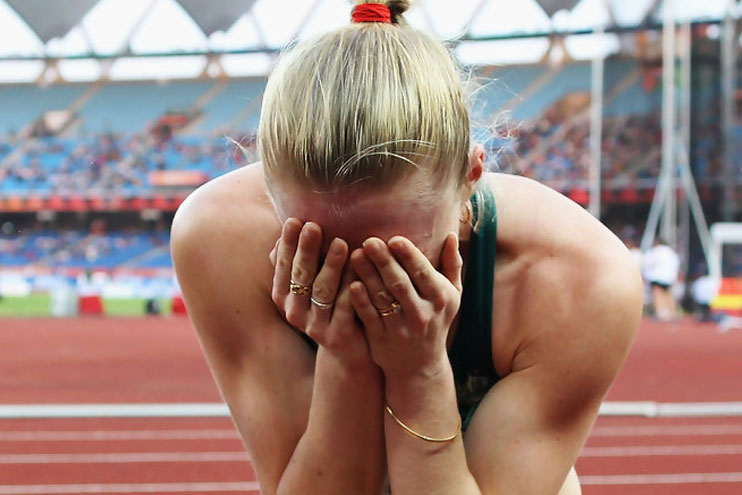
Sally Pearson after her victory in Delhi 2010. (CGA Archive)
A few days, Pearson returned to the Jawaharlal Nehru Stadium ready for the women’s 100m hurdles, an event she was the reigning Olympic silver medallist, yet an event she stumbled in four years earlier.
“I had to ensure I did everything right… I didn’t hit any hurdles along the way, I just wanted to get to that finish line,” Pearson said.
“I always had confidence in my ability to be able to get that gold medal, I just wanted to get this job done and I said to myself ‘we are here to do it and to win my first international gold.’
“It was important to put your name on the international circuit… yes I’m here and I’m ready to win more races… it was super important to me, more mentally than anything that I can do it and I can win gold medals.
“I can be competitive on the world stage and this is just a stepping stone… towards bigger and better things to come… for the future.”
Pearson also erased the disappointment of her 2006 hurdles fall to become only the fourth Australian to win the hurdles gold at a Commonwealth Games behind Strickland at the Auckland 1950 Games, Norma Thrower at the Cardiff 1958 Games, and the incomparable Pam Kilborn (Ryan) winning at the Perth 1962 Games, Kingston 1966 Games and Edinburgh 1970 Games.
After her Delhi triumph and her Olympic win, Sally returned to defend her crown in Glasgow in 2014, but another hurdle appeared in Sally’s journey when was she was robbed of a Kilborn equaling three-peat on the Gold Coast when forced out of the team at the last minute with an injury.
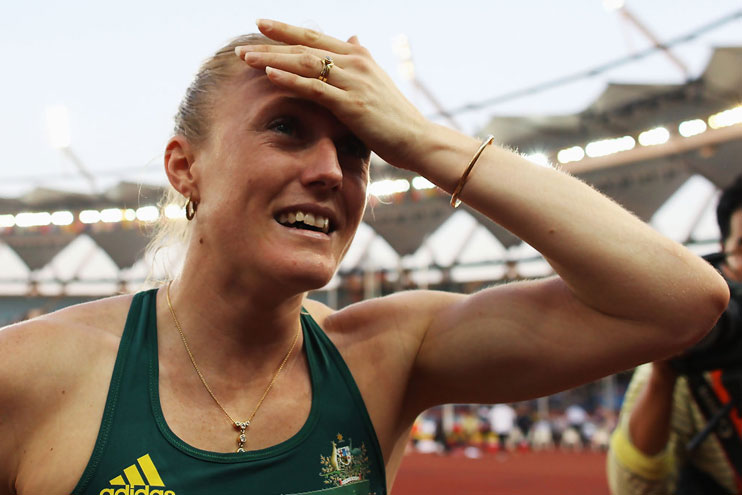
Sally Pearson in the moments following her victory. (CGA Archive)
And the story behind the infamous run in the final of the 4x400m on the final day of competition in Delhi?
“I actually went to a meeting and they sat me down and said we want you to run the 4×4 and I can’t really remember the words I said but I was thinking, ‘I really, really don’t want to do this, but if they really think it’s going to help the team then I’ll step up’,” Pearson said.
“But I’m not promising anything special… I’ll do my very, very best but I’m not a 400m runner.
“I haven’t been training for it and there is a big difference to running 100 to 400m on the track.
“But they had belief in me.
“I didn’t eat a thing that day because I was so nervous… I looked at food and wanted to be sick.
“And when I got onto the track it was like a dream… I couldn’t believe where I was and what I was doing.
“I remember grabbing the baton off Olivia Tauro and taking off, thinking I was going quite well and then someone came flying past me and I thought ‘that’s right I’m running against international 400m runners here’ I better get my butt into gear.
“In the end I split around 52.5 which is really quite reasonable for me… I had never run anything close to that even in an individual race.
“Then I was being held up as I was coming through the media area and I was vomiting at the same time, so it wasn’t a pretty sight but its something I’m never going to forget because it’s something I’m never going to experience running a 400m at an international level ever again.
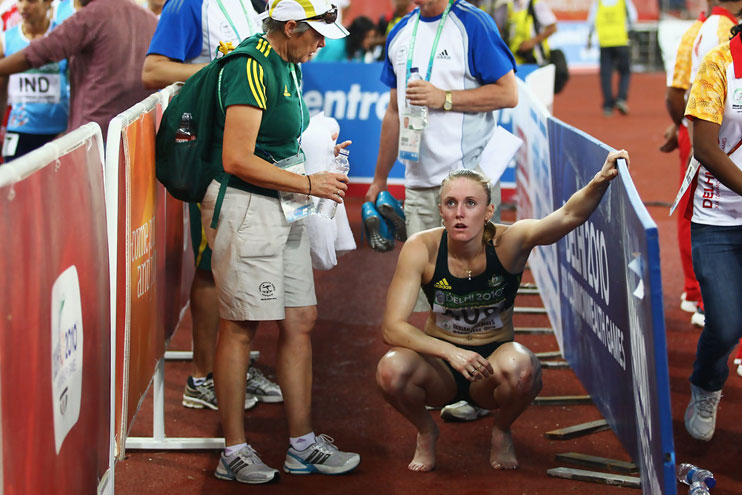
Sally Pearson following her gut-busting effort in the 4x400m relay final. (CGA Archive)
“I was hallucinating and I actually thought there were stairs on the track, I was walking and lifting my feet up as if I was walking up stairs.
“It was such a bizarre feeling… probably the worst lactic acid I’d ever felt but we do these things as an athlete, we step up and help our teammates out but if I ever get called into a meeting like that again it won’t be happening.”
Pearson concluded it was a dramatic Games but says being on an Australian team was the most important thing.
“Delhi was a bit of a mess and a shambles at times but it’s all part of the experience, we have to have these competitions in countries like India to allow people to realise this is what it is like around the world and if it can inspire the next generation of athletes in this country to do better for themselves, to become top athletes,” Pearson said.
“It is really important to ensure we spread the love around the world in all different types of countries.
“It was tough sometimes but at the same time I wasn’t going to let anything stop me from winning my first international gold medal.
“You just have to suck it up and do it.
“The competition is going to go ahead whether you like it or not, you just have to make the best of it and make the most it and we have all these stories to talk about in the future.”
And the now Olympic champion and two-time Commonwealth Games gold medallist’s final word.
“It was no doubt a mixed bag of emotion and a big learning curve for me which I think has better helped me to shape myself as an athlete going forward and how I dealt with things… a big bag of emotions that set me up for the rest of my career.”
